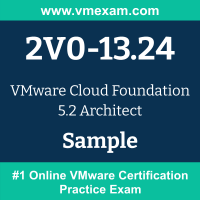 We have prepared VMware Cloud Foundation 5.2 Architect (2V0-13.24) certification sample questions to make you aware of actual exam properties. This sample question set provides you with information about the VCP-VCF Architect exam pattern, question formate, a difficulty level of questions and time required to answer each question. To get familiar with VMware Certified Professional - VMware Cloud Foundation Architect (VCP-VCF Architect) 2024 exam, we suggest you try our Sample VMware 2V0-13.24 Certification Practice Exam in simulated VMware certification exam environment.
We have prepared VMware Cloud Foundation 5.2 Architect (2V0-13.24) certification sample questions to make you aware of actual exam properties. This sample question set provides you with information about the VCP-VCF Architect exam pattern, question formate, a difficulty level of questions and time required to answer each question. To get familiar with VMware Certified Professional - VMware Cloud Foundation Architect (VCP-VCF Architect) 2024 exam, we suggest you try our Sample VMware 2V0-13.24 Certification Practice Exam in simulated VMware certification exam environment.
To test your knowledge and understanding of concepts with real-time scenario based VMware 2V0-13.24 questions, we strongly recommend you to prepare and practice with Premium VMware VCP-VCF Architect Certification Practice Exam. The premium VMware VCP-VCF Architect certification practice exam helps you identify topics in which you are well prepared and topics in which you may need further training to achieving great score in actual VMware Certified Professional - VMware Cloud Foundation Architect (VCP-VCF Architect) 2024 exam.
VMware 2V0-13.24 Sample Questions:
01. What is a common cause of performance issues in VMware vSAN storage within VMware Cloud Foundation?
a) Excessive memory usage on the management cluster
b) Incorrect virtual switch configurations
c) Insufficient vCPU allocation
d) Misconfigured storage policies
02. Which of the following is critical when analyzing the business objectives for a VMware Cloud Foundation deployment?
a) Understanding the required performance and availability requirements
b) Prioritizing the security of the management domain
c) Focusing only on budget constraints
d) Ensuring the hardware is compatible with VMware
03. In a conceptual model for VMware Cloud Foundation, which of the following components is typically included?
a) The exact number of ESXi hosts and storage devices
b) The specific models of the servers to be used
c) Detailed configurations of the management components
d) Logical groupings of services such as compute, storage, and networking
04. Given a scenario, what is the best approach for monitoring VMware Cloud Foundation health and performance?
a) Using a custom dashboard to monitor each individual VCF component manually
b) Implementing VMware vRealize Operations for health, performance, and capacity management
c) Setting up SNMP-based monitoring to capture basic infrastructure data
d) Relying on VMware Cloud Foundation native tools for monitoring and alerting
05. To meet performance requirements for a VCF deployment, which action should be taken?
a) Use only SSDs for all storage components in the solution
b) Allocate additional CPU cores to the vCenter Server
c) Implement VMware NSX for network optimization
d) Deploy workloads across a single physical site for low-latency communication
06. When creating a VMware Cloud Foundation logical design for a VCF Workload Domain, what must be considered?
a) The network topology within the data center
b) The firewall and load balancer configuration
c) The workload types and their resource consumption requirements
d) The exact specifications of the hardware to be used
07. What is the first step when gathering business requirements for a VMware Cloud Foundation solution?
a) Assessing the network bandwidth available
b) Selecting cloud providers
c) Identifying the physical hardware to be used
d) Defining the business and technical objectives
08. Which design decision is critical for monitoring VCF workload components?
a) Implementing automated troubleshooting tools for all VCF workloads
b) Using VMware vRealize Log Insight for centralized log management
c) Configuring VMware vSphere HA to track VM availability
d) Setting up VMware vRealize Automation for workload performance tracking
09. When analyzing requirements for VMware Cloud Foundation, which two factors must be taken into account to ensure scalability and future growth?
(Choose two)
a) The management requirements for the SDDC
b) Existing network infrastructure capabilities
c) The expected number of workloads to be migrated
d) The availability of storage within the data center
10. In a VMware Cloud Foundation stretched cluster architecture, what is the primary benefit?
a) Improved network performance across regions
b) Reduced total cost of ownership (TCO) by using fewer hosts
c) Easier configuration of storage policies
d) Increased resilience to outages across sites
Answers:
Question: 01
Answer: d |
Question: 02
Answer: a |
Question: 03
Answer: d |
Question: 04
Answer: b |
Question: 05
Answer: c |
Question: 06
Answer: c |
Question: 07
Answer: d |
Question: 08
Answer: b |
Question: 09
Answer: a, c |
Question: 10
Answer: d |
Note: Please update us by writing an email on feedback@vmexam.com for any error in VMware Certified Professional - VMware Cloud Foundation Architect (VCP-VCF Architect) 2024 certification exam sample questions
 We have prepared VMware Cloud Foundation 5.2 Architect (2V0-13.24) certification sample questions to make you aware of actual exam properties. This sample question set provides you with information about the VCP-VCF Architect exam pattern, question formate, a difficulty level of questions and time required to answer each question. To get familiar with VMware Certified Professional - VMware Cloud Foundation Architect (VCP-VCF Architect) 2024 exam, we suggest you try our Sample VMware 2V0-13.24 Certification Practice Exam in simulated VMware certification exam environment.
We have prepared VMware Cloud Foundation 5.2 Architect (2V0-13.24) certification sample questions to make you aware of actual exam properties. This sample question set provides you with information about the VCP-VCF Architect exam pattern, question formate, a difficulty level of questions and time required to answer each question. To get familiar with VMware Certified Professional - VMware Cloud Foundation Architect (VCP-VCF Architect) 2024 exam, we suggest you try our Sample VMware 2V0-13.24 Certification Practice Exam in simulated VMware certification exam environment.